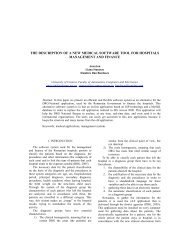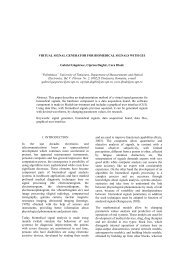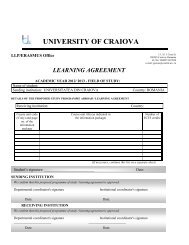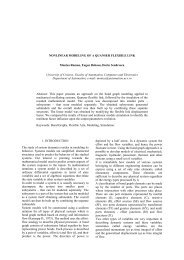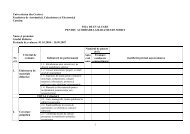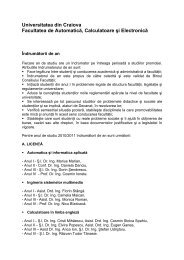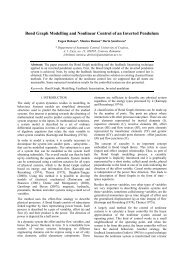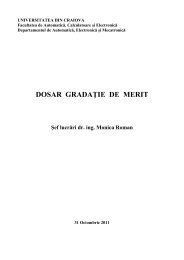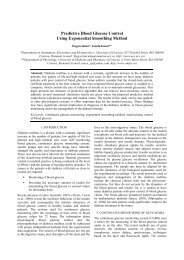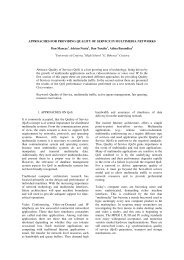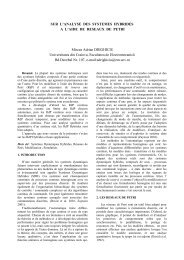collaborative distance learning within laboratories by using virtual ...
collaborative distance learning within laboratories by using virtual ...
collaborative distance learning within laboratories by using virtual ...
You also want an ePaper? Increase the reach of your titles
YUMPU automatically turns print PDFs into web optimized ePapers that Google loves.
The first tangible results are to be reported in<br />
autumn 2003 at a Workshop dedicated purposely to this<br />
goal.<br />
With regard to <strong>collaborative</strong> feature of projects it<br />
could be mentioned a successful recent development<br />
called IVDS - that is the International Virtual Design<br />
Studio. This project was carried out <strong>by</strong> a Consortium<br />
composed of the Union Collage (USA), Queen's<br />
University (Canada) and MEDU University (Turkey).<br />
The objective of IVDS is to provide a <strong>collaborative</strong><br />
design experience to students in different international<br />
locations (Notash L., 2003).<br />
The IVDS was created in 1996 <strong>by</strong> the Union Collage<br />
in Schenectady, NY, and Middle East Technical<br />
University in Ankara, in response to the need to develop<br />
the skills among students that are necessitating to<br />
complement the emerging global environment of today's<br />
workplace. After that in 1997 Queen's University of<br />
Kingston, Ontario, joined the project team.<br />
Eventually IVDS provides teams with international<br />
culture interaction and team building, long <strong>distance</strong><br />
project collaboration and communication, creative<br />
thinking, and project management experience.<br />
The work on IVDS project and its outcomes pertain<br />
to the area of geographically distributed student groups<br />
linked <strong>by</strong> Internet, to constitute multicultural design<br />
teams aiming to develop a creative thinking. It could be<br />
appreciated that IVDS is a remarking project since it<br />
includes both design and international components. The<br />
assessments show that the students find it a very<br />
positive experience where they work as international<br />
teams during which they learn many important issues<br />
related to design engineering. The IVDS allows students<br />
across the world to work together in engineering design<br />
projects, while challenged with cultural, educational<br />
differences.<br />
4. CONCLUSIONS<br />
Virtual laboratory experiments have many<br />
advantages, like a comprehensive usage <strong>by</strong> many<br />
universities, a bigger number of available experiments,<br />
a higher level valued experiments, that are independent<br />
of place and time, and are not requiring travel costs and<br />
time. Anyhow our experience with development of such<br />
laboratory shows that in order to be efficient they<br />
require more intensive advices, media competence of<br />
the tutors, live "presence" and feedback of the students<br />
about the <strong>laboratories</strong>. Collaboration and workgroup<br />
should be initiated <strong>by</strong> the tutor of the laboratory<br />
experiment and supported <strong>by</strong> <strong>collaborative</strong> exercises.<br />
REFERENCES<br />
Aktan, B.; Bohus, C.A.; Crowl, L.A.; Shor, M.H.<br />
(1999): Distance Learning Applied to Control<br />
Engineering Laboratories, IEEE Transactions on<br />
Education, Vol. 39, No. 3.<br />
Casini, M., Prattichizzo, D., Vicino. A.; (2003), The<br />
Automatic Control Telelab: A User-Friendly Interface<br />
for Distance Education, IEEE Transaction on Education,<br />
Vol. 46, 2003<br />
Cernian, O., Hamburg, I., Mancas, D. (2003)<br />
Distributed Learning Environments - Examples, Inforec<br />
magazine, ASE Bucharest<br />
Gokhale, A. (1995), Collaborative Learning Enhances<br />
Critical Thinking. Journal of Technology Education, 7, 1<br />
ISSN1045-1064<br />
Hamburg, I., Cernian, O., ten Thij, H. (2003): Lernen<br />
und Kooperieren in verteilten Umgebungen: die Chance<br />
für die betriebliche Weiterbildung! Engert, S., Hamburg,<br />
I. (Hrsg.): IT-basierte Lernformen für die betriebliche<br />
Weiterbildung. Gelsenkirchen: Inst. Arbeit und<br />
Technik, S. 45-55.<br />
Henry, J. (1996): Controls Laboratory Teaching via<br />
the World Wide Web. In Proc. ASEE Annual<br />
Conference, Washington, USA.<br />
Jochheim, A.; Röhrig, C. (1999): The Virtual Lab for<br />
Teleoperated Control of Real Experiments. In Proc. IEEE<br />
Conference on Decision and Control, Phoenix, USA<br />
Johnson, R.T., Johnson, D. W. (1986). Action<br />
research: Cooperative <strong>learning</strong> in the science classroom.<br />
Science and Children, 24, 31-32<br />
Notash, L., Garriock, M., 2003, International Virtual<br />
Design Studio (IVDS) Program: Overview, Challenges,<br />
and Students' Perspective, IEEE Transactions on<br />
Education, Vol. 43, 2003<br />
Röhrig, C., Jocheim , A. (2000): A Java-based<br />
Framework for Remote Access to laboratory<br />
Experiments. Proc. IFAC/IEEE Symposium on Advances<br />
in Control Education, Goald Coast, Australia.<br />
Schmid, C. (1999): A Remote Laboratory Using<br />
Virtual Reality on the Web, Simulation, Vol. 73, No. 1.<br />
Shirmohammadi, S.; Oliveira J.C.; Georganas, N.D.<br />
81998): Applet-Based Telecollaboration: A Networkcentric<br />
Approach. IEEE Multimedia, Vol. 5, No. 2, pp.<br />
64-73, 1998<br />
Totten, S., Sills, T., Dig<strong>by</strong>, A., Russ, P. (1991),<br />
Cooperative Learning: A guide to research. New York:<br />
Garland



